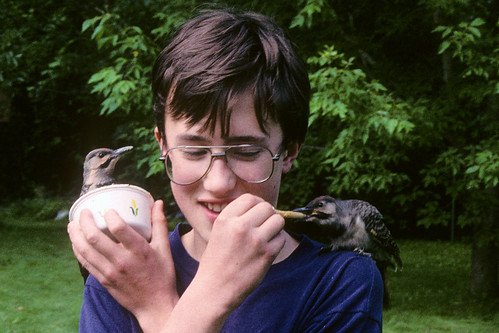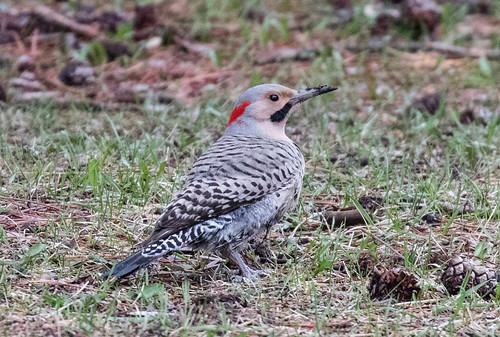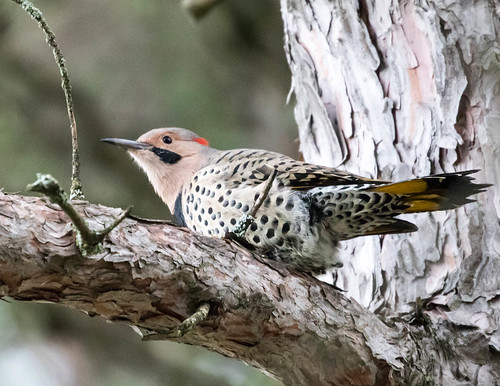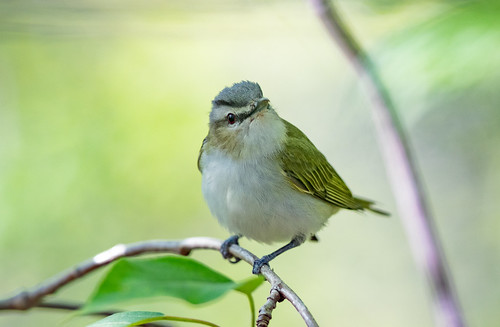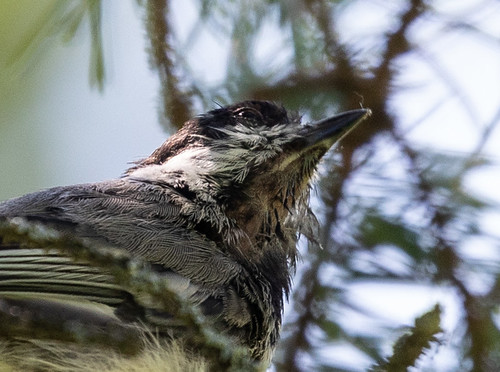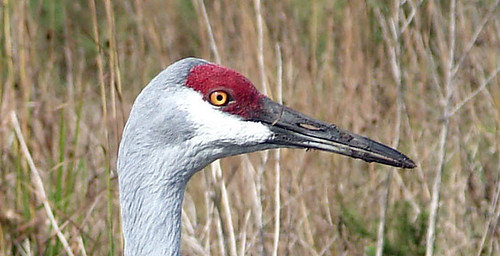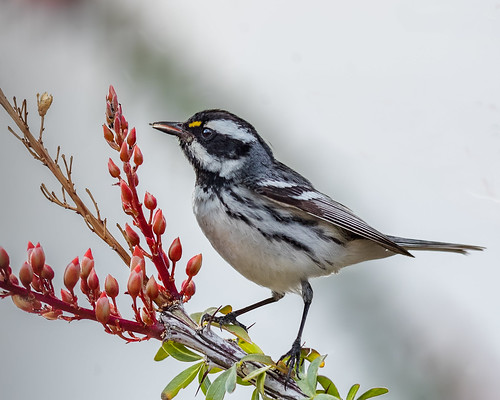I have a lot of memories of the first time Russ and I came up to northern Wisconsin to visit his parents in Port Wing after I became a birder. That first week of September in 1975, I added 13 lifers, and even more memorable were some of my experiences—walking with Russ on Sand Beach in the Apostle Islands National Lakeshore, we saw raccoon and mink footprints but no human or dog prints, and I studied a little Lapland Longspur working its way along the beach, moving slowly and deliberately enough for me to have plenty of time to page through my field guide figuring out who it was.

Before this trip, I’d already seen plenty of Cedar Waxwings, but suddenly they were conspicuous and everywhere, whole flocks perched in big snags and slender dead branches rising above shrubs, darting out to catch flying insects. Some were tucked into those shrubs, feeding on berries, but even they were noticeable, making their high-pitched sleepy snores, contrasting with the raspy mews catbirds were making within those same shrubs.
I not only added ravens to my lifelist but also had ample opportunity to compare their calls and flight silhouettes to those of crows. I had somehow managed to miss both Yellow-rumped and Palm Warblers entirely my first spring of birding, despite their being two of the very most abundant of all warblers, but in Port Wing that early fall, I made up for lost time, seeing them everywhere and memorizing their call notes. The dry chip of the Yellow-rump sounded to my ears like an annoyed math teacher; the slightly more liquid one of the Palm Warbler more like an annoyed music teacher.

But of all the memorable birding experiences I had that September, most vividly impressed on my memory are the flickers. I’d seen my first one way back in May, and saw them here and there throughout spring and summer, but now, that first week of September in northern Wisconsin, they were everywhere, acting not at all like the woodpeckers I knew they were. Whenever Russ and I walked or drove along any dirt road or my in-laws’ gravel driveway, flickers flew up ahead of us, showing off their unmistakable bold white rump and flashes of brilliant yellow on their wings and tail. I found quite a few fairly large feathers along the beach with bold yellow shafts and the vanes on just the underside vivid yellow, giving me an appreciation of the dangers of migration as well as the beauty of flickers.
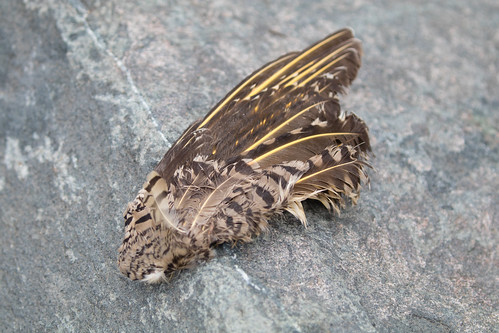
When I could park myself down before flushing one, I could watch them picking up ants. I vaguely remembered something about that from ornithology class, but it was much more vividly impressed on my brain when I could actually watch them. Flickers eat more ants than any other bird, and also take a wide variety of beetles, wasps, grasshoppers, crickets, grubs, and other insects. They’ve even been reported flycatching—that is, darting out to capture flying insects on the wing.
To sweeten their diet, about 40 percent of their food is vegetal, especially berries and other fruits. They seem especially fond of poison ivy berries, helping to disseminate their seeds. They also take some acorns, beechnuts, and other seeds.
Flickers are one of the birds that are beloved by just about anyone who sees them, and they’re seen by a lot of people in North America. They can be found year round in most of the Lower 48 states, Cuba, and well down into Mexico and Central America. The vast majority of them retreat south from the northernmost states in winter, and a great many breed in the northern states, much of Canada, and Alaska. Indeed, they breed further north than any other woodpecker except the Three-toed Woodpecker.
The common flicker is the State Bird of Alabama. Alabama has been known as the "Yellowhammer State" since the Civil War. The yellowhammer nickname was applied to the Confederate soldiers from Alabama when a company of young cavalry soldiers from Huntsville, under the command of Rev. D.C. Kelly, arrived at Hopkinsville, KY, where Gen. Forrest's troops were stationed. The officers and men of the Huntsville company wore fine, new uniforms, whereas the soldiers who had long been on the battlefields were dressed in faded, worn uniforms. On the sleeves, collars and coattails of the new cavalry troop were bits of brilliant yellow cloth. As the company rode past Company A, Will Arnett cried out in greeting "Yellowhammer, Yellowhammer, flicker, flicker!" The greeting brought a roar of laughter from the men and from that moment the Huntsville soldiers were spoken of as the "yellowhammer company." The term quickly spread throughout the Confederate Army and all Alabama troops were referred to unofficially as the "Yellowhammers."
When the Confederate Veterans in Alabama were organized they took pride in being referred to as the "Yellowhammers" and wore a yellowhammer feather in their caps or lapels during reunions.
A bill introduced in the 1927 legislature by Representative Thomas E. Martin, Montgomery County, was passed and approved by Governor Bibb Graves on September 6, 1927.
Roger Tory Peterson often wrote about the flicker that sparked his love for birds. In a 1937 National Audubon Society leaflet , he wrote about an experience he had when he was about 11 years old with his friend Carl, who:
found a dead bird on a tree…There it was, about four feet from the ground, clasping the trunk, its bill nuzzled into the feathers of its back. It was a flicker, a beautiful thing, the first one we had ever seen. We were wondering how the poor creature had died in such a manner when I ventured to poke it with my finger. The “dead” bird suddenly came to life, looked at us in amazement, and bounded away!
Arthur Cleveland Bent, the author and compiler of the comprehensive Life Histories of North American Birds was also struck by a seemingly lifeless flicker when he was a boy, though in his case the bird really was dead. He wrote:
I can remember as clearly as if it were only yesterday my boyish, enthusiastic admiration for this beautiful bird, though it was between 50 or 60 years ago that my father first showed me a freshly killed flicker. I was simply entranced with the softly blended browns, the red crescent on the head, the black crescent and bold spotting on the breast, and, above all, with the golden glow in the wings and tail. Few birds combine such charming colors and pleasing contrasts. I have never lost my admiration for it, and still consider it one of nature’s gems.
Franklin L. Burns listed 123 vernacular names for this species in a monograph about flickers. Arthur Cleveland Bent included only one nickname in his Life History, “the ‘partridge woodpecker,’ suggestive of my boyhood days, when flickers, meadowlarks, and robins were considered legitimate game.” John James Audubon did not consider flickers good eating—he disliked the bitter taste flicker meat took on from the formic acid permeating the bodies of the flicker’s favorite food (and the reason ants belong to the family Formicidae). Unlike Audubon, many people enjoyed the spicy flavor enough that flickers were commonly seen strung up with other birds at old meat markets.
Reading Bent’s account, originally published in 1939 when he was 73 years old, certainly reflects the sensibilities of earlier generations, and not only in terms of people eating flickers. He extolled the beauty of their eggs:
The eggs of the flicker are pure lustrous white, with a brilliant gloss; the shell is translucent, and, when fresh, the yolk shows through it, suffusing the egg with a delicate pinkish glow, which is very beautiful.
Yet most of his discussion of eggs relates to collecting. In particular, he focuses on how many eggs various collectors managed to take from individual flickers, inducing them to produce additional eggs which they in turn collected. He wrote:
My neighbor, Charles L. Phillips, tried the experiment of taking one egg each day, leaving one as a nest egg; he holds the extraordinary record of having taken 71 eggs from one nest in 73 days; the poor bird rested only two days in the long strain of over two months.
Unlike the humans who didn’t show much mercy to flickers, at least one wild predator was quite tender with a flicker family. Bent writes:
W.I.Lyon (1922) tells an interesting story of a screech owl that adopted and brooded a family of young flickers, after its own nest in the same tree had been broken up twice; the owl even brought in part of a small bird, perhaps intending to feed it to the young flickers, which were all the time being fed by their parents and were successfully raised.
Nesting deep in cavities protects woodpeckers from the elements and many predators, but it comes at a cost—when an adult is incubating eggs or brooding young, both energy-intensive jobs, carbon dioxide builds up because there is so little air circulation. Both parents take turns during daytime, but perhaps to even up their physical contributions to the young after the female produced the clutch, the male takes night duty. Once the babies hatch, the adults will be flying in and out with food, which keeps bringing in fresh air, but to minimize the amount of time in the egg, baby woodpeckers are hatched out while they’re extremely undeveloped compared to most birds.
Bent quoted Althea Sherman’s lovely description of a newly hatched flicker:
The pellucid color of the newly hatched Flicker resembles that of freshly sun-burned human skin, but so translucent is the nestling’s skin that immediately after a feeding one can see the line of ants that stretches down the bird’s throat and remains in view two or three minutes before passing onward.
I got lots of
flicker recordings this spring—they were among the most vociferous of my backyard birds in terms of the amount of time they spent vocalizing and the volume of their calls. As Arthur Cleveland Bent wrote, “The flicker has an elaborate vocabulary; no other woodpecker, and few other birds, can produce a greater variety of loud striking calls and soft conversational notes.”
The name flicker fits the species visually because of the flickerings of brilliant color we notice when we see them in flight, and the word flicker has for hundreds of years, at least since Chaucer, been used with reference to birds in general, but the reason the name stuck for American flickers may well be that one of their calls seems to be flicka, flicka, flicka—Merriam Webster says the etymology of the name for the bird is “probably imitative of its call.”

There are lots of dead trees in and around my backyard. I don’t like tracking my birds too closely, because my crows track me, and I don’t want to inadvertently give away any other birds’ secrets, but I know my flickers nested either in my own old aspen tree or in one of the dead trees in the little woodland behind my house. After the babies fledged, there were a couple of days when I got to observe them, but they were so quiet and still that it took some luck to notice them in the first place and some work to keep track of them. Intriguingly, they seemed to fly off when they heard a parent call, rather than noisily calling the parents to them. I blundered into that strategy of calling the babies to me when raising our flickers, but it turns out to be what real flicker parents do, too.

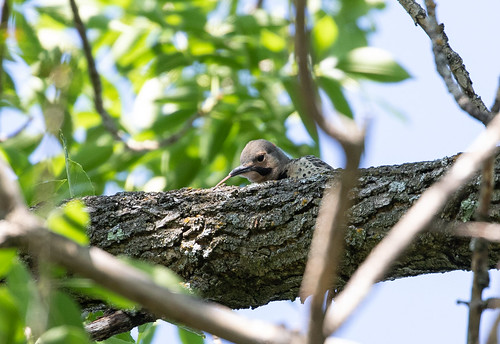
The flicker babies and their parents are all growing new feathers right now, feathers that will have to serve them for a full year. Now that the young are flying well, they seem to be accompanying their parents more, meaning none of them need to call very much, so these families are mostly silent. The parents are still subsidizing the chicks with feedings even as those youngsters grow skilled at finding their own food. This last week of July, I have heard a few flickers yelling out, but haven’t heard any drumming or the extended calls that made this spring so thrilling.
Soon these families will be moving on for the year, gathering with other families in loose but rather large flocks, especially conspicuous on volleyball, soccer, and other sporting fields, dirt roads, and gravel driveways. They often migrate along shorelines, their swoopy flight, yellow underwings and tail, and white rump making them easy to identify.
Their rather slow, predictable flight makes them fairly easy for Peregrine Falcons and other raptors to grab, which is why their brilliant and sturdy feathers are so often picked up along shorelines. We can watch flickers migrating by day, but they also migrate by night, which we know from the carcasses we pick up in the morning beneath lighted buildings and towers. Mortality during migration is apparently high, but according to the Bird Banding Laboratory, some have lived over 9 years, and Kennard's "Longevity Records of North American Birds," published in Bird-Banding in 1975 listed one flicker who had survived 12 years 5 months.
Fortunately, flickers were once very abundant species, because throughout their range, their population is declining rather dramatically. I once rescued one bird that was entangled in monofilament and hopelessly snagged on a tree trunk. Fortunately, when I cut it free of the fishing line, it was sturdy and healthy enough to fly off.
Their numbers may be smaller than in previous decades, but of an August or September day, they still gather on the ground, these quintessential birds of late summer, the very species Roger Tory Peterson cited when saying birds are the most vivid representation of life itself. Seeing them this time of year, my thoughts always travel back in time to that memorable first birding trip to Port Wing, Wisconsin, lo those 45 years ago.






